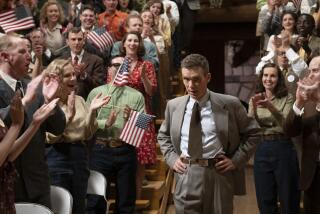Interest in the Historical Lore of Old Glory Is Not Flagging
- Share via
Question: Because American flags are so much in the news these days, given the flag-desecration controversy, I wanted collectors to know that there are many of us who have put together significant American flag collections over the years.
I would think that the value of a flag is tied to the number of stars it has--that is, the fewer the stars, the older the flag and, hence, the more valuable it is. Is that a good rule of thumb?--W.M.
Answer: As long as the flag is in good condition--no tears, few or no loose threads, no dirt smears or discoloration--then that rule generally applies.
Size counts too. Obviously, a small, hand-held flag may not bring as much on the collectible market as a flagpole version of Old Glory.
If a flag is tied (no pun intended) to a special occasion--such as the 48-star variety worn by the American infantry under the camouflage net of their helmets during the D-Day invasion--then a premium would be attached to it. (Dealer catalogue prices on this particular flag, for example, show that it has been selling for at least $30 and more.)
Other prices for authenticated American flags, going back a century or more, have varied from about $50 to several hundreds of dollars, depending on scarcity, condition and where the flag was first used.
The first American flags included the Continental or Grand Union flag, consisting of 13 alternate red-and-white stripes with a British Union Jack in the upper left corner. It was first flown on Jan. 1, 1776, near Boston.
On June 14, 1777, the Continental Congress adopted a flag design similar to the Continental flag, but with a significant difference: The Union Jack was replaced by a blue field with 13 stars.
Whether Betsy Ross actually fashioned the first stars and stripes pattern has been the subject of unending historical debate.
Bookshelf
Consider the outhouse.
Collectible author Ronald S. Barlow of El Cajon did, and the result is a nostalgic 136-page paperback coffeetable-size paperback, “The Vanishing American Outhouse.”
Containing nearly 200 color photographs and plan drawings of American privies constructed from 1820 to 1940, the book will definitely appeal to collectors looking for offbeat stuff and to anyone searching for a quaint back-yard conversation piece.
Included are outhouses ranging from an ornate structure once belonging to a Georgetown, Colo., mining baron, complete with gingerbread trim, to the austere variety discovered in ghost town ruins. Mixed in are anecdotes, poems and folklore.
“I haven’t met anyone who owns more than half a dozen,” said Barlow, who is selling the book for $15.95 a copy, plus $1.50 postage and handling (Windmill Publishing Co., 2147 Windmill View Road, El Cajon, Calif. 92020).
For a nation that prides itself on being on the cutting edge of technology, Barlow notes in his introduction, there are still about “4 million old-fashioned privies in back yards from Maine to California.”
“Of course, this is not anywhere near the 50 million ‘unplumbed households’ reported in the 1950 census, but we have put a man on the moon since then.”
Hardly a topic of conversation in a civilized society, Barlow says, outhouses nevertheless are catching the eyes of landscape architects, who “are moving many of these quaint folk art buildings to the back yards of their wealthiest clients. Even a good reproduction can run you up to $2,500 before any electrical or plumbing hookups.”
In this genre of collectibles, Barlow told us that even outhouse post cards of the 1930s have been selling for $2 apiece and that post cards with pictures of Victorian privies have sold for as much as $25 each.
And for the collector who has everything, he says, privy seat boards are sought for wall decorations, adding: “Back East, three holes in hardwood bring $150.”
More to Read
Sign up for The Wild
We’ll help you find the best places to hike, bike and run, as well as the perfect silent spots for meditation and yoga.
You may occasionally receive promotional content from the Los Angeles Times.






